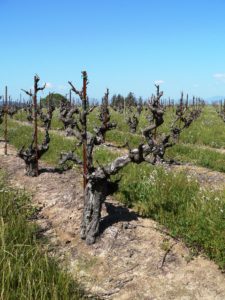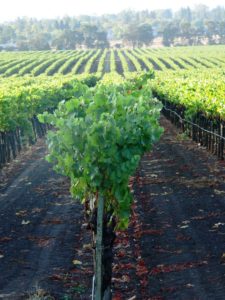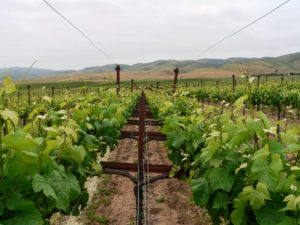Choosing a Trellis System
While numerous training and pruning systems exist, three basic canopy structures serve as a starting point in deciding on the best trellis system for your vines.
Vineyards are not natural systems. If a grapevine had its way, it would: (a) not be grafted onto some strange rootstock of a different species mix, (b) not be grown on some shattered rock hillside nor in the middle of the desert, (c) have its fruit eaten by birds or deer rather than being shipped across the county or state to some processing plant, and (d) rather grow up the side of a tree than up a steel stake and thin wire. Trellis systems were developed to channel the grapevine’s natural tendency to grow upon other structures into a form that serves our purposes for improving both vineyard productivity and wine quality.
Over the years, there have been countless variations on trellis system designs. Coupled with numerous training and pruning styles (most generally divided into either cane or spur-pruning, or hybrids of both), the number of permutations of trellis, training and pruning systems is mind-boggling. Many of the trellis systems developed in the last few decades have come from universities and growers in cool-climate grape growing regions (e.g., New Zealand, New York, Oregon and some regions of France).
The goal of much trellis development has been to maximize the leaf area to capture more sun energy and increase productivity in regions that experience short seasons (due to late spring and early fall frosts). But those systems do not always perform well in warmer growing regions where they may be completely inappropriate.
There is no need to cover all of the trellis types and training systems out there. I have found that the topic is well covered in Freeman et al., 19881. I will instead discuss the systems in general terms. I like to think of three basic categories with regard to their canopy structure: head-trained, non-divided and divided vine canopies.
Head-trained

In a head-trained vineyard, vines are not trained onto a trellis but are left to be on their own (not connected to other vines by a trellis system). In actuality, a cane-pruned vine that is on a trellis is also head-trained, but the common colloquialism for non-trellised vines is “head-trained.” Australians refer to them as “bush vines,” which is probably a more meaningful descriptor.
Head-trained vines are trained to a vertical trunk, often without a strong support structure and are usually pruned to spurs that emanate from all directions out of the center. Most often, the shoots are allowed to grow without any manipulation, where they droop over and trail on or near the ground. Many older vineyards were planted in this fashion, which allows for planting on a square grid, and cultivation or other cultural practices may be performed in two directions (i.e., cross-wise). Such vineyards are frequently non-irrigated.
Some people swear that this system is the only way to grow Zinfandel and, because of that feeling, a few new Zinfandel vineyards are still being planted in this manner. It is, however, likely that Zinfandel grown on a different trellis system can match the quality of a head-trained vineyard.
The major disadvantage of this system is that it is not easily managed using machinery, which makes it uneconomical for most operations. Machines, such as sprayers, leafers and cane-cutters, work in a linear fashion, and the head-trained vine is not trained in a line. Furthermore, the fruit may get buried under layers of foliage, especially on vigorous sites. Under those conditions, some fruit will not receive ample sunlight, possibly causing fruit to ripen unevenly. Additionally, it may be difficult for protective sprays to penetrate into the cluster zone when under the thick blanket of foliage. That is why this system is most effective on low-vigor, non-irrigated hillsides where shoot growth does not become rampant.
One adaptation of the head-trained, spur-pruned vine is the Gobelet system, in which the shoots are tied up to a stake (which also supports the vine), forming a goblet shape. This avoids the cluster shading indicated above but leaves the fruit potentially overexposed to direct sunlight.
In another variant, the vines are cane-pruned, and the canes are tied up to a central stake. The vertical canes, however, are more likely to develop conditions for variable fruit maturation within the interior of the canopy.
Aside from its traditional association with fine Zinfandel vineyards, the primary advantage to the head-trained trellis system is that the vineyards are stunningly beautiful during the winter dormant season.
Non-divided Single Fruit Zone

The “single fruit zone” category undoubtedly captures the majority of the systems in use, at least in California. These trellises have one single fruiting zone that forms, in the abstract, a straight line running down the vine row.
At its most basic, a single fruiting wire supports a horizontal cordon (or canes), and the shoots are left to grow in many different directions. This has been referred to as the “California Sprawl,” but that notoriety has been largely negative. That is because many sprawl vineyards have historically been over-irrigated and over-fertilized to the point where foliage was everywhere and not a cluster was to be seen without some serious digging.
Notwithstanding the jungle-style sprawl vineyard, the single-wire trellis, if managed properly, can be the best solution for many operations. Warm, interior valleys and some coastal valleys that experience several hot spells per year might be better off with a single-wire system than with a more modern shoot-positioned system. The “fuzzier” canopy of the single-wire trellis will allow less direct sunlight into the fruit zone, which will protect the fruit from overheating. It is important to manage the water and nutrition of these vines so that they do not venture into the classic California Sprawl territory.
The T-trellis was and is still used to lift the foliage up and away from the fruit zone. Two additional catch wires at the ends of a crossarm (hence the “T”) retain the shoots as they grow upward. For this system, the shoots will need to be tucked between the catch wires, which usually requires more than one pass through the vineyard.
Shoot-positioned trellis systems are the current state of the art and are found in most high-end coastal vineyards. Shoots are positioned vertically upwards as they grow, using movable wires to lift the shoots. The vertically-shoot positioned (VSP) system allows for rows to be positioned more closely together, thus increasing productivity per acre. But the primary reason for such a system is to provide an optimal sunlight environment in the cluster zone, known as a “dappled” light. Fruit is generally located in a single linear band, which promotes uniformity of quality and ripening. That is why winemakers generally favor this system over most others.
Generally speaking, little or no leaf removal is necessary in VSP systems although some leafing is often practiced, especially in tight-clustered varieties2. The VSP trellis may not be the best solution in interior valleys as fruit may be under-protected from sunlight and may be damaged during heat events.

Another downside to the VSP is that it does not perform well in high-vigor situations. Some of the vigor may be toned down through wider spacing of the vines, which allows for a greater amount of wood (dormant buds) to be retained per vine. However, on high-vigor sites, foliage may become too dense, and leaves become scrunched up within the tight space between the wires, creating a leaf canopy that does not collect sunlight efficiently. Furthermore, vigorous vineyards will require repeated passes with a cane-cutter in order to maintain the hedgerow shape that is sought after. Multiple cane-cuttings per season (an unacceptable situation in my mind) is a sign that the vineyard was poorly designed from the beginning.
There are other variations on the undivided fruit zone theme, including splitting the foliage into two curtains (Wye trellis) that alleviates some of the foliage bunching that occurs in the VSP. More commonly, positioning wires may be spaced out wider so that the foliage is not as compressed.
Divided Fruit Zone Canopies

Divided fruit zone (or divided canopy) trellis systems all have two fruit zones. They can be horizontally or vertically divided, though the horizontally divided trellis systems are by far the most common. While some winemakers may be convinced that the divided trellis is simply a way for growers to satisfy their greed, most often it is a way to deal with a vigorous site that cannot be trained to a single fruit zone without excessive vegetative growth. Most of these systems will have two parallel fruit zones, spaced about two to three feet apart. Vines are usually trained to cordons in a quadrilateral configuration (an “H” shape when looking from above) or in an “S” or “U” shape. Vines may also be trained to a head and cane-pruned to four canes.
The shoots are usually positioned either straight up or are tilted over a bit and are positioned with “rake wires” that open up the center of the canopy to allow sunlight to penetrate. There are many variations on this theme, but the most common is probably the Open Lyre trellis system. In the Geneva Double Curtain (GDC) system, developed in New York, the cordons are trained high up and shoots are encouraged to droop downward. The GDC system is not appropriate for warm growing regions as the fruit tends to be overexposed to sunlight.
Horizontally divided systems have two fruit zones that overlay one another in a vertically oriented plane. They are all very similar to the VSP in that they are usually shoot-positioned. However, the upper tier in such systems is similarly trained to a VSP while the lower tier is inverted and the shoots are positioned downward so that the lower tier does not shade out the upper.

There are several variations on the horizontally divided theme. The terminologies seem to keep getting mixed up and I am always frustrated in trying to figure out exactly which name goes with each training system. Nonetheless, Scott Henry, an Oregon winegrower and winemaker, developed the original system of this kind. He laid out four canes per vine and trained each pair to a different fruiting wire. The lower canes were rolled over and positioned downward, thus leaving two fruit zones open. There have been variations, including the use of cordon-trained vines and alternating up- and down-trained vines within the row3.
In my experience, vertically divided trellis systems are appropriate only for cool-climate viticultural regions. In warm and hot climates the fruit zones tend to be far too exposed to direct sunlight and the fruit is often damaged by excessive heat, especially in the lower tier, which is closer to the warm soil.
The Best Trellis System
I share the winemakers’ preference for single-canopied trellis systems. As I mentioned several months ago in an earlier article4, two fruit zones, whether divided horizontally or vertically, will develop under different light and/or temperature conditions and will not have the same qualities at the end of the season. For the same reason, they will not ripen simultaneously; and if care is not taken to harvest them individually, wine quality is unlikely to attain the same levels of quality as a single-canopy system.
With that said, I understand that there are numerous vineyard sites where a single fruit zone canopy may simply become a green monster; therefore creating a divided canopy will be completely appropriate for those locations.
And so, what is the best trellis system for winegrapes? One might as well ask, what is the best variety of winegrapes?
By Mark Greenspan
1 Freeman, B.M., E. Tassie and M.D. Rebechi. “Training and Trellising,” Viticulture. Volume 2 Practices. B.G. Coombe and P.R. Dry, editors. Pp. 42-84.
2 Greenspan, M.D. “Pitfalls of Overexposed Fruit.” Wine Business Monthly. September 2006.
3 Smart, R. and M. Robinson. 1991. Sunlight into Wine. Winetitles.
4 Greenspan, M.D. “Taming Fruit Variability.” Wine Business Monthly. December 2005.
(Original Version of this article appeared in Wine Business Monthly in October 2006)
Photo Citations
(Main Photo) Turley Zinfandel Hayne Vineyard: 1993 – 2015 (May 2018): Vinous – Explore All Things Wine. (n.d.). Retrieved January 04, 2021, from https://vinous.com/articles/turley-zinfandel-hayne-vineyard-1993-2015-may-2018
King, C. (2020, April 9). Trellis Management at Atwater Vineyards in the Finger Lakes of New York. Retrieved January 04, 2021, from https://www.atwatervineyards.com/index.cfm?method=blog.blogList


